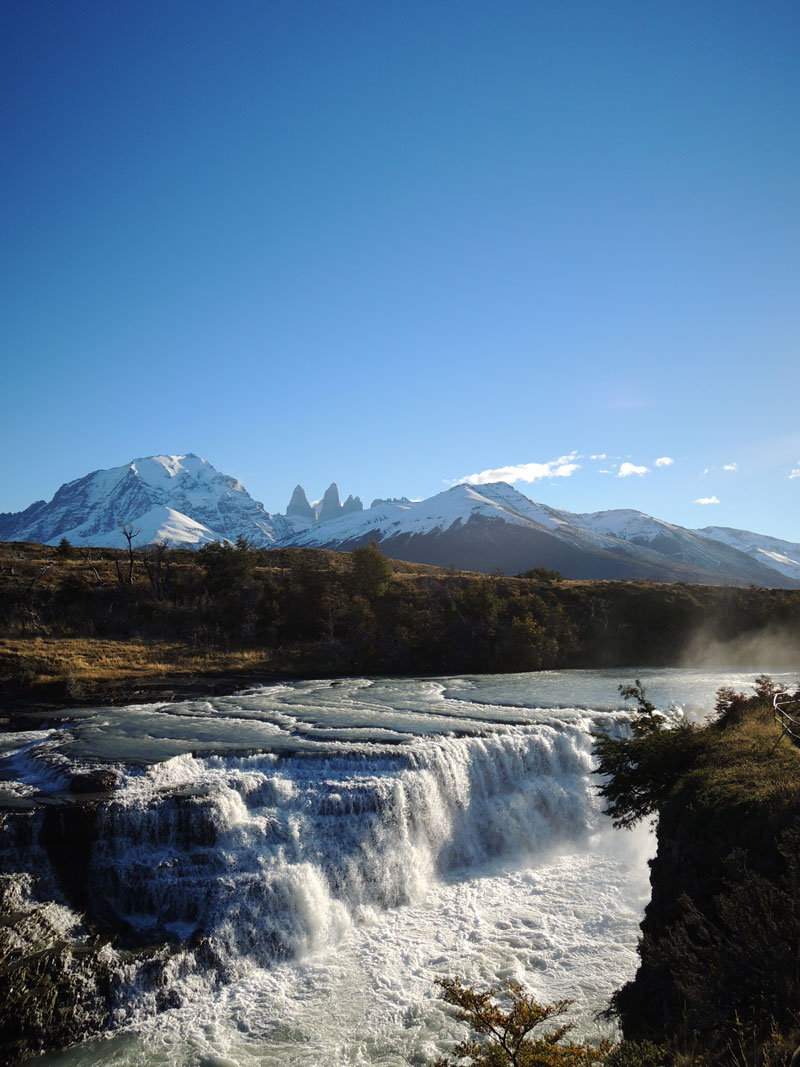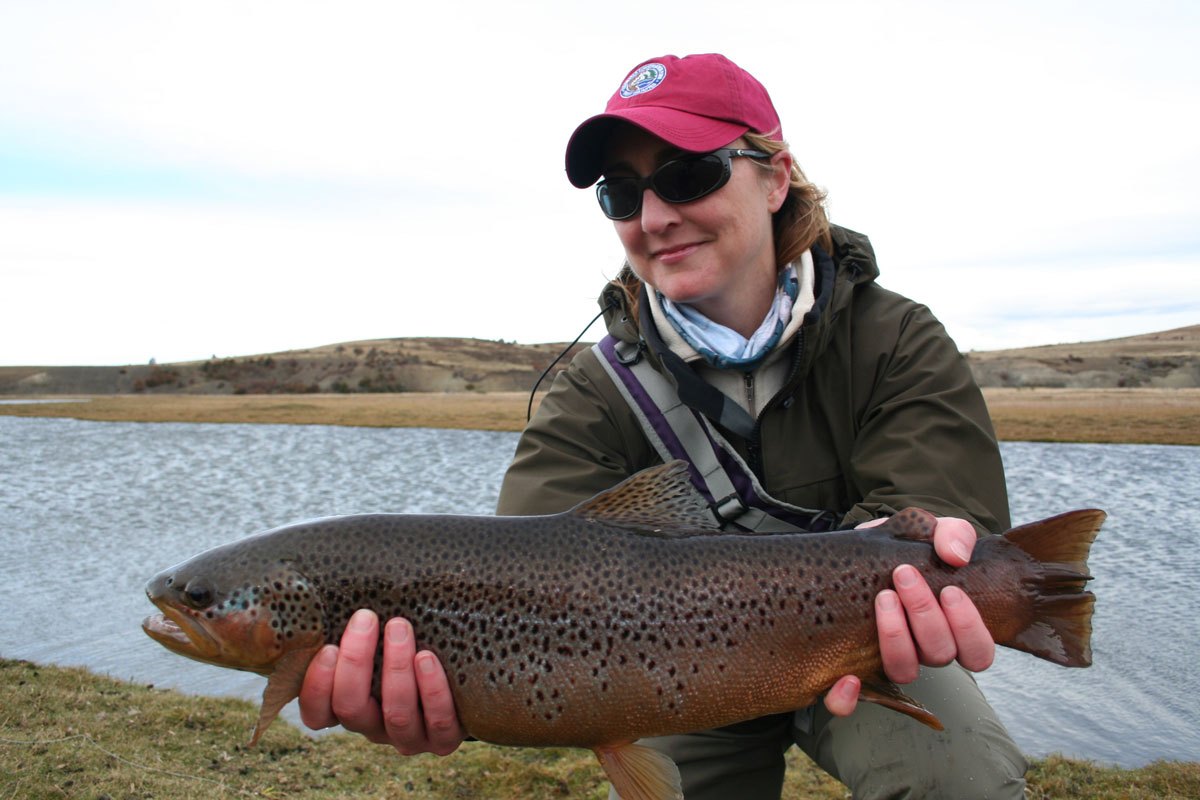I opened the door of the Suburban and swung out my legs. The thud of my wading boots on the packed, dry earth startled me back to attention. I’d been hypnotized for the last hour, sitting in the back seat and staring out the window, while the truck was slowly maneuvered across the roadless ranchland.
It was the view. That view! It was magnificent. Mesmerizing. The air was so clear and unpolluted that the sky was Technicolor blue. Was that actually real? It could have been a movie set.
Closing the door behind me, I turned around to take it all in. Miles upon miles of dusty earth. Parched brush hurling tumbleweed-style in the ever-present winds. Native guanaco (a camelid) and nandu (Darwin’s rhea) roamed and grazed freely, while rabbits and armadillos scurried along. The trees, hauntingly beautiful with their twisted, craggy branches dripping with sage-gray lichen, were reaching for the sun and retreating from the wind simultaneously. Even I, who admittedly have no internal compass, knew which way was east. And in the middle of the valley, a winding river full of trout.

But the reason the hairs on my neck stood at attention like the hackles of a Royal Wulff: Torres Del Paine, the iconic black granite towers of the southern Andes Mountains, watched over all of it. And for the first time in my life, over me as well.
Words were useless as I turned to my South American companion. I didn’t need them. His dark eyes crinkled, amused, as he broke into a wide smile, equally in awe of his native country’s beauty.
In his thickly accented English he expressed my thoughts perfectly. “Welcome to Jurassic Park.”
Like many of you, I’m sure, Patagonia has always been a destination on my fly fishing bucket list. So when my friend and South American tackle distributor, Claudio Joost, suggested I join him to fish with an eco-tourist outfitter based in Puerto Natales, Chile, I agreed enthusiastically. I’m always up for an adventure. My next thought was, where the heck is that? Claudio gave me the suggested itinerary and travel routes from my Washington, D.C. home, which would include multiple transfers and layovers to reach Punta Arenas, one of the world’s southernmost cities, and end with a three hour drive back north to the lodge. I was about to embark on a 35 hour trek to the base of the earth.
Arriving at our basecamp for the next week, the Remota Hotel, I couldn’t get a sense of just how remote we were. The mid-April evening, being the advent of autumn, was pitch black halfway through the drive. Puerto Natales is not a bustling metropolis, but has become quite the tourist town being that it’s the gateway to Torres Del Paine National Park, one of the most visited areas of Patagonia, just one hour north. The hotel, however, was on the outskirts of town where few lights were illuminated and a cloud-filled sky shielded any moonlight.
That first night we met with Claudio Molina, the hotel’s general manager and an avid fly angler, who would be taking advantage of the end-of-summer break from tourists to sneak away and be our guide. He was nearly as excited as we were. Over dinner and several bottles of Chilean Cabernet Sauvignon, we three, along with the full-time fishing and eco-tourism guides on staff, reviewed the type of fishing to expect.
Rivers are narrow, yet deep. Water flows can be quite fast, roaring at times, trenching deep holes and undercut banks for the otherwise camouflage-free trout that would be migrating upstream for the autumn spawn. Sink tip lines are essential to help streamers cut through the strong currents and descend rapidly. Rod weights of 7 to 9 are best. Strikes would be quick, yet hard, and staying focused would be the key to setting the hook. But once hooked up, hang on – these fish are rod-benders. In the summer months of December and January, the fish cruise the expansive network of spring creeks. Floating lines, light leaders and dry flies, including terrestrials and other attractors, are the norm.
The following morning I leaped from my bed to the window to finally get a glimpse of where I was. Remota is built on a hill overlooking one of Chile’s many fjords. The site of fishable water usually excites me, but a blazing pink sunrise highlighting the surrounding mountain got my pulse racing. After spending so many hours of the past two days sitting – on planes, in waiting areas, in cars - I was ready to fish.
The two Claudios and I met early in the quiet hotel lobby. “Bundle up,” my friend said. It was good advice. Weather is a force of its own in this part of the country and it changes unpredictably. It was cold, damp and windy (always the wind), and it was not unusual to have bright sunshine, driving rain and a snow squall in the course of an afternoon.
Our first stop was to the Rio Las Chinas. I recalled our previous evening’s tutorial as I tied on a heavy, black streamer with a pink head and orange rubber legs. Pure meat. Casting was difficult. I was sloppy. Getting my rod to load the line was not coming easily. They’ll never admit it, but I know the two gentlemen flanking me on the bank were holding their breath.

After some time and several self-deprecating sighs, I relaxed and got my rhythm down. I could focus on the swift drift of the fly and anticipate the strike. Claudio Molina taught me a technique to help draw the line out of the deep swirls – roll cast the line upstream once or twice to get the system in motion, and then quickly and seamlessly use the building energy to leverage the fly out of the water for the backcast. It was a brilliant move for someone lacking brute strength. My arm was grateful.

Fishing was slow to start, but quickly turned on. I was missing strikes. I gladly listened to another lesson – to strip my line-hand back while simultaneously lifting the rod. This was a familiar technique, one that I frequently use when fishing for bass. From then on, it was game on.
Brown trout were stocked in Patagonia in the 1800s and proliferated in the river system, which is nutrient-rich from glacier melt. Sometimes referred to as ‘black trout,’ many are darker, more gray than gold, and have black tipped fins and backs. Blending with the dark-bottomed, muddy spring creeks, they can stay unseen from resident condors, eagles and other scouting predators, a necessary adaptation when trees and other forms of cover are scarce. Their fins are short – almost stubby – and their bodies are thick and powerful.
With many of the fish I fought to land, I held my breath until the net was heavy. Over the course of four days we fished several rivers including Rio Baguales, under the breathtaking view of the Andes and where I imagined T-Rex had once reigned, and Rio Santucci, a lovely spring creek with calm, clear water and dense grasses along the banks.
Taking a break mid-week, we traded our boots from wading to hiking to explore the wonders of Torres Del Paine National Park. In the early morning, we boarded a ferry that took us up close and personal with Grey Glacier, the glowing slabs of compact ice that make up the Southern Patagonian Ice Field. Afterward, we basked in the sun while hiking around lakes and waterfalls, searching out fossils, and lunching below the Paine massif. And while it would be easy to spend an entire week exploring this eco-traveler’s paradise, the fish were calling us back.
There are multiple fly fishing outfitter options north of Puerto Natales in Chilean Patagonia, but if you want to fish near Torres Del Paine – a great way to share a once-in-a-lifetime vacation with non-angling friends and family – the Orvis-endorsed program at Remota Hotel is your only option. The area is primarily privately owned – horse, sheep and lama ranches (estancias) that range from 5,000 to 100,000 acres. Each ranch may have a modest family house, a small shed for equipment, and a rancher’s outpost when the property is of larger scale. There are few corrals, few barns and no grain silos. All is left open and wild with the exception of running fences to delineate property lines.

Unless you get inside those fences, you don’t realize how much water is flowing through those estancias.
In Chile, the public is allowed to walk onto private land to fish, but not drive a car. At this point, there are five ranch owners that allow Remota guides to shuttle guests through their property for fishing, an exclusive arrangement not afforded to the other 100-plus travel outfitters in the area. While that may not sound like a lot of fishing opportunity, one needs to remember the size of a typical ranch. Upon entering a property’s gate, the drive to that day’s fishing spot could take nearly an hour. While the majority of the hotel’s guests are exploring the national park with the other 150,000 annual tourists, the few visiting anglers are very remote indeed.
The Remota Hotel is not only your destination for comfortable eco-adventure with a full-time staff of trained tour guides offering over 30 excursions to explore the nearby sites; it’s also an architectural marvel. The award-winning design, constructed by Chilean architect Germán del Sol, strives to blend the interior space with the external landscape. After a day of fishing or hiking, guests can relax in the infinity pool or sauna, or enjoy a glass of sparkling wine next to one of the fully vented indoor fire pits. Be prepared to eat and drink exceptionally well, both in the lodge and streamside.

Chile is a land of agricultural riches from north to south, coastal and inland. The chef features a wide range of local ingredients including tropical fruits of the northern desert region, such as key limes and avocados, to succulent king crab, harvested off the nearby southern coast.
To get there, fly to Punta Arenas on either LAN or Sky airlines. Most routes include a transfer in the capital city of Santiago. Remota offers a shuttle, a three hour drive to and from the airport, which is a detail to factor in when scheduling flights, especially the departure. To break up the return trip, spend a day or two in bustling Santiago, visiting the numerous museums and enjoying the lively nightlife. And a visit to Chile’s lush wine region is just minutes from downtown.
